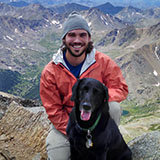
Earth and Atmospheric Science
Natural and Health Sciences
After completing his doctorate in 2012, Dr. Lerach spent a year as a visiting assistant professor of meteorology in upstate New York at The College at Brockport. He has been at UNC since the fall of 2013, where he teaches the following courses:
Check out Dr. Lerach's Classes website
Dr. Lerach's interests lie in mesoscale meteorology, with applications in radar meteorology and numerical weather prediction (NWP). Specifically, his research makes use of the Regional Atmospheric Modeling System (RAMS) and polarimetric radar hydrometeor identification (HID) techniques to explore various aerosol-cloud microphysical impacts on tornadic storms, orographic snowfall events, and other types of precipitating systems. His work aims to improve upon existing numerical microphysical parameterizations in order to more accurately represent (1) the evolution of deep convective systems and their cold pools in high-resolution numerical weather forecast models and (2) the placement and intensity of extreme snowfall in regions of complex terrain for applications in snowpack stability and avalanche prediction.
Colorado is a beautiful and majestic place, but the Rocky Mountains are home to many natural hazards, nearly all of which are affected by extreme weather events unique to the region. As a professor of meteorology, avid backcountry enthusiast, and member of the National Ski Patrol (NSP), Dr. Lerach hopes to help spread regional weather and climate awareness in the community and the potential impacts on mountain environments. He is a member of Diamond Peaks Ski Patrol, a volunteer organization based in Fort Collins, Colorado that is dedicated to backcountry and avalanche safety. The patrol offers avalanche safety as well as mountain travel and rescue classes to the public every year, and Dr. Lerach teaches the sections pertaining to weather: topics such as cloud types and their significance, large-scale weather patterns, orographic (terrain-forced) precipitation and other extreme weather, weather effects on snowpack and avalanche considerations, and how to view/use online weather information. His involvement with NSP also affords him the privilege to train members of U.S. Special Forces in backcountry travel and mountain weather each winter.
Learn more about Dr. Lerach's Research
Lerach, D. G., and N. R. Yestness, 2019: Virtual Storm Chase: Bringing the atmospheric sciences to life through an interactive case study. J. College. Sci. Teaching, 48, 30-36.
Lerach, D. G., and W. R. Cotton, 2018: Simulating southwestern U.S. desert dust influences on supercell thunderstorms. Atmos. Res., 204, 78-93.
Lerach, D. G., and W. R. Cotton, 2012: Comparing Aerosol and Low-Level Moisture Influences on Supercell Tornadogenesis: Three-Dimensional Idealized Simulations. J. Atmos. Sci., 69, 969-987.
Lindsey, D. T., B. McNoldy, Z. Finch, D. Henderson, D. Lerach, R. Seigel, J. Steinweg-Woods, E. Stuckmeyer, D. Van Cleave, G. Williams, and M. Woloszyn, 2011: A High Wind Statistical Prediction Model for the Northern Front Range of Colorado. Electronic J. of Operational Meteor.
Lerach, D. G., S. A. Rutledge, C. R. Williams, and R. Cifelli, 2010: Vertical Structure of Convective Systems during NAME 2004. Mon. Wea. Rev., 138, 1695-1714.
Lerach, D. G., B. J. Gaudet, and W. R. Cotton, 2008: Idealized Simulations of Aerosol Influences on Tornadogenesis. Geophys. Res. Let., 35, L23806, doi:10.1029/2008GL035617.
Lerach, D. G. and W. R. Cotton, 2007: Airborne dual-Doppler radar observations of a bow echo over Minnesota on 3 July 2003 during BAMEX. 12th Conf. on Mesoscale Processes, Waterville Valley, New Hampshire, Amer. Meteor. Soc., 12.7.